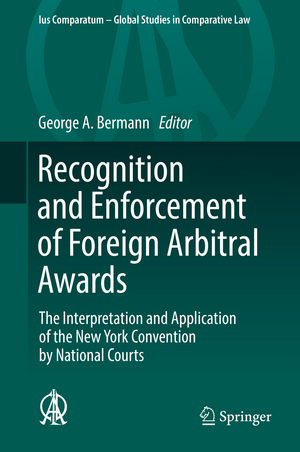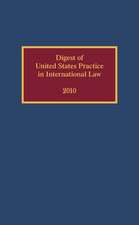Recognition and Enforcement of Foreign Arbitral Awards: The Interpretation and Application of the New York Convention by National Courts: Ius Comparatum - Global Studies in Comparative Law, cartea 23
Editat de George A. Bermannen Limba Engleză Hardback – 31 iul 2017
Following introductory remarks, each report addresses the following aspects of the Convention which include its basic implementation within the national legal system; enforcement by local courts of agreements to arbitrate (including grounds for withholding enforcement), recognition and enforcement of foreign awards by local courts under the Convention (including grounds for denying recognition and enforcement), and essential procedural issues in the courts’ conduct of recognition and enforcement. Each report concludes with an overall assessment of the Convention’s interpretation and application on national territory and recommendations, if any, for reform.
The New York Convention was intended to enhance the workings of the international arbitral system, primarily by ensuring that arbitral awards are readily recognizable and enforceable in States other than the State in which they are rendered, subject of course to certain safeguards reflected by the Convention’s limited grounds for denying recognition or enforcement. It secondarily binds signatory states to enforce the arbitration agreements on the basis of which awards under the Convention will be rendered. Despite its exceptionally wide adoption and its broad coverage, the New York Convention depends for its efficacy on the conduct of national actors, and national courts in particular. Depending on the view of international law prevailing in a given State, the Convention may require statutory implementation at the national level. Beyond that, the Convention requires of national courts an apt understanding of the principles and policies that underlie the Convention’s various provisions. Through its in-depth coverage of the understandings of the Convention that prevail across national legal systems, the book gives practitioners and scholars a much-improved appreciation of the New York Convention “on the ground.”
| Toate formatele și edițiile | Preț | Express |
|---|---|---|
| Paperback (1) | 1967.01 lei 6-8 săpt. | |
| Springer International Publishing – 22 iun 2018 | 1967.01 lei 6-8 săpt. | |
| Hardback (1) | 2787.02 lei 6-8 săpt. | |
| Springer International Publishing – 31 iul 2017 | 2787.02 lei 6-8 săpt. |
Din seria Ius Comparatum - Global Studies in Comparative Law
- 18%
 Preț: 1584.40 lei
Preț: 1584.40 lei - 18%
 Preț: 1009.22 lei
Preț: 1009.22 lei - 18%
 Preț: 1573.51 lei
Preț: 1573.51 lei - 18%
 Preț: 1255.16 lei
Preț: 1255.16 lei - 24%
 Preț: 1515.12 lei
Preț: 1515.12 lei - 24%
 Preț: 802.76 lei
Preț: 802.76 lei - 15%
 Preț: 651.84 lei
Preț: 651.84 lei - 18%
 Preț: 958.56 lei
Preț: 958.56 lei - 24%
 Preț: 812.88 lei
Preț: 812.88 lei - 15%
 Preț: 653.33 lei
Preț: 653.33 lei - 15%
 Preț: 654.43 lei
Preț: 654.43 lei - 18%
 Preț: 1401.16 lei
Preț: 1401.16 lei - 18%
 Preț: 1007.80 lei
Preț: 1007.80 lei - 18%
 Preț: 898.89 lei
Preț: 898.89 lei - 18%
 Preț: 956.99 lei
Preț: 956.99 lei - 18%
 Preț: 789.98 lei
Preț: 789.98 lei - 15%
 Preț: 644.95 lei
Preț: 644.95 lei - 18%
 Preț: 953.97 lei
Preț: 953.97 lei - 18%
 Preț: 1009.85 lei
Preț: 1009.85 lei - 18%
 Preț: 955.08 lei
Preț: 955.08 lei - 18%
 Preț: 1010.03 lei
Preț: 1010.03 lei - 18%
 Preț: 1403.67 lei
Preț: 1403.67 lei - 18%
 Preț: 2114.90 lei
Preț: 2114.90 lei - 18%
 Preț: 2107.49 lei
Preț: 2107.49 lei - 18%
 Preț: 997.71 lei
Preț: 997.71 lei - 18%
 Preț: 955.40 lei
Preț: 955.40 lei
Preț: 2787.02 lei
Preț vechi: 3398.80 lei
-18% Nou
Puncte Express: 4181
Preț estimativ în valută:
533.36€ • 579.15$ • 448.02£
533.36€ • 579.15$ • 448.02£
Carte tipărită la comandă
Livrare economică 22 aprilie-06 mai
Preluare comenzi: 021 569.72.76
Specificații
ISBN-13: 9783319509136
ISBN-10: 3319509136
Pagini: 975
Ilustrații: XIV, 1102 p. 1 illus.
Dimensiuni: 155 x 235 x 64 mm
Greutate: 1.72 kg
Ediția:1st ed. 2017
Editura: Springer International Publishing
Colecția Springer
Seria Ius Comparatum - Global Studies in Comparative Law
Locul publicării:Cham, Switzerland
ISBN-10: 3319509136
Pagini: 975
Ilustrații: XIV, 1102 p. 1 illus.
Dimensiuni: 155 x 235 x 64 mm
Greutate: 1.72 kg
Ediția:1st ed. 2017
Editura: Springer International Publishing
Colecția Springer
Seria Ius Comparatum - Global Studies in Comparative Law
Locul publicării:Cham, Switzerland
Cuprins
Introduction.- 1. Recognition and Enforcement of Foreign Arbitral Awards: The Interpretation and Application of the New York Convention by National Courts.- 2. Interpretation and application of the New York Convention in Argentina.- 3. Interpretation and application of the New York Convention in Australia.- 4. Interpretation and application of the New York Convention in Austria.- 5. Interpretation and application of the New York Convention in Brazil.- 6. Interpretation and application of the New York Convention in Canada.- 7. Interpretation and application of the New York Convention in China.- 8. Interpretation and application of the New York Convention in Colombia.- 9. Interpretation and application of the New York Convention in Croatia.- 10. Interpretation and application of the New York Convention in Czech Republic.- 11. Interpretation and application of the New York Convention in France.- 12. Interpretation and application of the New York Convention in Georgia.- 13. Interpretation and application of the New York Convention in Germany.- 14. Interpretation and application of the New York Convention in Greece.- 15. Interpretation and application of the New York Convention in Hong Kong.- 16. Interpretation and application of the New York Convention in Hungary.- 17. Interpretation and application of the New York Convention in India.- 18. Interpretation and application of the New York Convention in Indonesia.- 19. Interpretation and application of the New York Convention in Ireland.- 20. Interpretation and application of the New York Convention in Israel.- 21. Interpretation and application of the New York Convention in Italy.- 22. Interpretation and application of the New York Convention in Japan.- 23. Interpretation and application of the New York Convention in Korea.- 24. Interpretation and application of the New York Convention in Macau.- 25. Interpretation and application of the New York Convention in Malaysia.- 26. Interpretation and application of the New York Convention in Mexico.- 27. Interpretation and application of the New York Convention in Netherlands.- 28. Interpretation and application of the New York Convention in Norway.- 29. Interpretation and application of the New York Convention in Paraguay.- 30. Interpretation and application of the New York Convention in Peru.- 31. Interpretation and application of the New York Convention in Portugal.- 32. Interpretation and application of the New York Convention in Romania.- 33. Interpretation and application of the New York Convention in Russia.- 34. Interpretation and application of the New York Convention in Singapore.- 35. Interpretation and application of the New York Convention in Slovenia.- 36. Interpretation and application of the New York Convention in Spain.- 37. Interpretation and application ofthe New York Convention in Sweden.- 38. Interpretation and application of the New York Convention in Switzerland.- 39. Interpretation and application of the New York Convention in Taiwan.- 40. Interpretation and application of the New York Convention in Turkey.- 41. Interpretation and application of the New York Convention in United Kingdom.- 42. Interpretation and application of the New York Convention in United States.- 43. Interpretation and application of the New York Convention in Uruguay.- 44. Interpretation and application of the New York Convention in Venezuela.- 45. Interpretation and application of the New York Convention in Vietnam
Notă biografică
George A. Bermann is the Jean Monnet Professor of EU Law, Walter Gellhorn Professor of Law, and the director of the Center for International Commercial and Investment Arbitration (CICIA) at Columbia Law School. Bermann is an active international arbitrator in commercial and investment disputes; chief reporter of the ALI’s Restatement of the U.S. Law of International Commercial Arbitration; chair of the Global Advisory Board of the New York International Arbitration Center (NYIAC); co-editor-in-chief of the American Review of International Arbitration; and founding member of the governing body of the ICC Court of Arbitration and a member of its standing committee.
Textul de pe ultima copertă
This book examines how the Convention on the Recognition and Enforcement of Foreign Arbitral Awards, commonly known as The New York Convention, has been understood and applied in [insert number] jurisdictions, including virtually all that are leading international arbitration centers. It begins with a general report surveying and synthesizing national responses to a large number of critical issues in the Convention’s interpretation and application. It is followed by national reports, all of which are organized in accordance with a common questionnaire raising these critical issues.
Following introductory remarks, each report addresses the following aspects of the Convention which include its basic implementation within the national legal system; enforcement by local courts of agreements to arbitrate (including grounds for withholding enforcement), recognition and enforcement of foreign awards by local courts under the Convention (including grounds for denying recognition and enforcement), and essential procedural issues in the courts’ conduct of recognition and enforcement. Each report concludes with an overall assessment of the Convention’s interpretation and application on national territory and recommendations, if any, for reform.
The New York Convention was intended to enhance the workings of the international arbitral system, primarily by ensuring that arbitral awards are readily recognizable and enforceable in States other than the State in which they are rendered, subject of course to certain safeguards reflected by the Convention’s limited grounds for denying recognition or enforcement. It secondarily binds signatory states to enforce the arbitration agreements on the basis of which awards under the Convention will be rendered.
Despite its exceptionally wide adoption and its broad coverage, the New York Convention depends for its efficacy on the conduct of national actors, and national courts in particular. Depending on the view of international law prevailing in a given State, the Convention may require statutory implementation at the national level. Beyond that, the Convention requires of national courts an apt understanding of the principles and policies that underlie the Convention’s various provisions. Through its in-depth coverage of the understandings of the Convention that prevail across national legal systems, the book gives practitioners and scholars a much-improved appreciation of the New York Convention “on the ground.”
Following introductory remarks, each report addresses the following aspects of the Convention which include its basic implementation within the national legal system; enforcement by local courts of agreements to arbitrate (including grounds for withholding enforcement), recognition and enforcement of foreign awards by local courts under the Convention (including grounds for denying recognition and enforcement), and essential procedural issues in the courts’ conduct of recognition and enforcement. Each report concludes with an overall assessment of the Convention’s interpretation and application on national territory and recommendations, if any, for reform.
The New York Convention was intended to enhance the workings of the international arbitral system, primarily by ensuring that arbitral awards are readily recognizable and enforceable in States other than the State in which they are rendered, subject of course to certain safeguards reflected by the Convention’s limited grounds for denying recognition or enforcement. It secondarily binds signatory states to enforce the arbitration agreements on the basis of which awards under the Convention will be rendered.
Despite its exceptionally wide adoption and its broad coverage, the New York Convention depends for its efficacy on the conduct of national actors, and national courts in particular. Depending on the view of international law prevailing in a given State, the Convention may require statutory implementation at the national level. Beyond that, the Convention requires of national courts an apt understanding of the principles and policies that underlie the Convention’s various provisions. Through its in-depth coverage of the understandings of the Convention that prevail across national legal systems, the book gives practitioners and scholars a much-improved appreciation of the New York Convention “on the ground.”
Caracteristici
Provides an organized overview of the Convention’s application in a large range of countries Addresses salient interpretation and application questions Concludes with an overall assessment of the Convention’s interpretation and application on national territory













